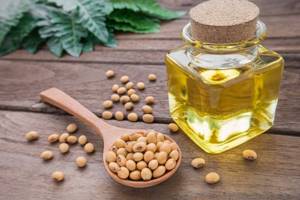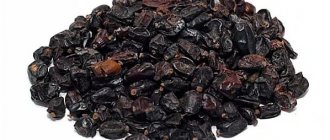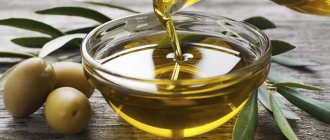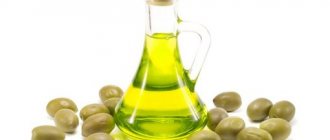general characteristics
People realized that oil can be obtained from soybeans back in the third millennium BC. And this discovery was made in Ancient China. It was there that the most ancient written references to the use of the product were found. But according to experts, there is nothing strange in this, since China (according to some sources, India) is considered the birthplace of this culture. In ancient China, soybean served as both food and medicine, and the plant itself was called divine. In those days, in the East they believed that soybean oil was the very elixir of youth that returned health, strength and beauty to a person.
Content:
- general characteristics
- Chemical composition
- Benefits for the body
- Possible harm and side effects
- Use in the food industry
- Use in cosmetology
- What else is useful
Real soybean oil has a bright straw-yellow or greenish color and a specific pungent odor. In industry, this product is obtained by pressing (mechanical method) or extraction (chemical method). The most useful is considered to be unrefined oil obtained by double pressing (cold pressing). But you need to understand that this type of product is not intended for long-term storage; it is characterized by a pungent odor and sediment. To extend the shelf life of the product, manufacturers resort to hydration, which, however, worsens the biological value of the oil. But, as a rule, what reaches the consumer is not pure oil, but refined oil - almost transparent, with a pinkish tint and without a strong aroma.
And Europeans learned about soybeans only in the 18th century. And that was first thanks to soy sauce, which the French were the first to try in Europe. Today, soybean oil is made from the fruits of a plant known in biology as soybean. It is grown mainly in tropical and subtropical regions, as well as in the Far East, Moldova, and Georgia. Soybean oil is on the list of the most popular among residents of China, Western Europe and the USA.
Chemical composition
According to scientists, soybean oil is the record holder among food products for the content of bioactive substances. But what’s most impressive is that it is almost 98% absorbed by the human body, which is a very high figure.
It is logical that soybean oil contains a huge amount of fat (thanks to them, the calorie content of 100 g of the product is almost 900 kcal). But this, it must be said, is not bad news at all. On the contrary, the “palette” of fats does not contain cholesterol, but is represented by healthy polyunsaturated fatty acids. In particular, approximately 50-60% of soybean oil consists of linoleic acid, and 20-30% of oleic acid. The product contains up to 7% stearic fatty acid, approximately 6% each of linolenic and palmitic acid. In slightly smaller quantities, scientists found arachidic, myristic and hexadecenic fatty acids in it. To summarize, 100 g of soybean oil contains 58 g of polyunsaturated fats, 23 g of monounsaturated and 16 g of saturated fatty acids. In addition, the soy product can be considered as a source of vitamins E, and, as well as iron and zinc.
Soybean oil (Glycine soja (Soybean) oil)
⇐ PreviousPage 5 of 5Vegetable fat. Contains 8 essential fatty acids. Mimics the action of estrogen in the skin. Soybean oil is a semi-drying fatty oil, a product of pressing or extraction of crushed soybeans (Glycine hispida). Light yellow liquid with a characteristic odor. The oil is often refined to improve flavor and extract phospholipids. Like all oils rich in essential fatty acids, it restores the epidermal barrier and moisture-holding capacity of the skin, and due to the presence of tocopherols and phytosterols it has a pronounced regenerating effect.
Calendula oil (Calendula officinalis flower extract) Suitable for all skin types, even very sensitive or baby skin. Ideal care product for sensitive skin. Suitable for oily skin care. Regulates the secretion of sebum, absorbs its excess, tightens pores. An excellent remedy for serious inflammatory processes, including acne. Accelerates skin regeneration and stimulates cell metabolism. Biologically active substances found in calendula flowers tone and improve metabolic processes in skin cells. Softens rough, cracked skin, prevents scars, and prevents scar formation. Calendula successfully resists varicose veins and capillary disorders; it is recommended for the treatment of rosacea, since with prolonged exposure, calendula oil helps eliminate the appearance of the venous network on the face. Increases skin resistance, recommended for daily protection of any skin type from aggressive environmental influences and bad weather. Natural UV filter, prevents sunburn. Used in cosmetics for dry sensitive skin. The cream increases the skin's resistance to adverse environmental factors, chemical or mechanical irritants. The high anti-inflammatory and wound-healing properties of the extract make it highly effective against skin inflammations, for example, eczema and allergic dermatitis, small wounds, burns, sunburn, bruises, etc.
Tocopherol/Vitamin E (Tocopherol)
Vitamin E. Slows down the aging process. Antioxidant. Heals various burns. Participates in the formation of collagen and elastic fibers of the intercellular substance.
Vitamin E is represented by several forms of fat-soluble polyunsaturated alcohols - tocopherols. The most active of them is alpha-tocopherol.
The name “tocopherol” itself comes from the Greek words tos “children” and pheros “birth”, emphasizing the special importance of vitamin E in reproductive function. Subsequently, another property of tocopherols was discovered. The presence of unsaturated (double) bonds in their molecule ensures the high antioxidant activity of vitamin E.
Vitamin E helps maintain the synthesis of collagen and elastin, prevents skin aging, neutralizes free radicals, prevents the effects of ultraviolet irradiation of the skin, improves blood microcirculation, and strengthens the walls of blood vessels.
Omega-6 Linoleic Acid
Promotes the accumulation of energy in cells, stabilizes body temperature, protects the skin from drying out and peeling; reproduction of a family of hormones necessary for cells, cellular biochemistry and energy metabolism.
Helps protect skin from drying and peeling.
Linoleic acid plays an important role in ensuring the barrier function of the skin. In cosmetics it is present in vegetable oils. It is found in significant quantities in flaxseed, sunflower, corn, and soybean oils.
Dimethiconol
Mineral oil gives the skin a pleasant feeling when applying the cream and promotes uniform absorption of nutrients.
Lactic Acid
Moisturizes the skin, normalizes the process of renewal of epidermal cells, which slows down with age; enhances the synthesis of glycosaminoglycans and collagen in the dermis.
Ethylhexylglycerin
Used as a stabilizer, antioxidant, preservative, emollient for cosmetics.
Emollient additive in skin care products. Improves the tactile properties of the emulsion.
Cyclorexasiloxane
Silicone, an emollient, gives the skin a feeling of softness and silkiness. Silicone, an emollient, gives the skin a feeling of softness and silkiness.
Cetearyl ethylhexanoate
Emollient. The function of emollients is due to their ability to remain on the surface of the skin to act as a lubricant, reduce skin dryness and improve its appearance.
Titanium dioxide
In cosmetic production, highly purified and finely dispersed titanium dioxide is used, which has the ability to reflect UV rays. Refers to inorganic UV filters. Such UV filters do not cause allergies and do not irritate the skin. Depending on specific conditions, it is used as a filler, as a white pigment, as a photoprotective additive in various products - powder, eye shadow, lipstick, antiperspirants, protective creams. Based on titanium dioxide, more advanced types of cosmetic raw materials are obtained, for example, pearlescent pigment ( titanated mica). For women with sensitive skin, the only sunscreen ingredients in cosmetics may be zinc oxide and titanium dioxide. Unlike chemical sunscreens that absorb ultraviolet rays, they do not cause allergenic effects on the skin because they deflect the rays more than they absorb them.
Propylene glycol
In cosmetics they are widely used in creams, tonics, moisturizers, serums, because... attracts and binds water. It is believed to give the skin a youthful appearance. It gives the skin a feeling of smoothness and hydration by moisturizing dead cells of the upper stratum corneum of the epidermis.
Silica
Gives silkiness and good glide to the finished product. Used in hypoallergenic cosmetics.
Squalane
Softening agent. UV filter, forming a protective film that prevents moisture loss, which, in turn, improves skin respiration.
The great interest in the use of squalane is mainly due to its natural skin compatibility, non-toxicity, high stability and pleasant silky feel of cosmetic preparations in which it is used. From a dermatological point of view, squalane is a high-quality emollient (softening agent). Thanks to its natural affinity for the skin, it easily penetrates the epidermis without leaving a greasy feeling, while leaving the skin feeling soft and silky. This excellent compatibility is explained by the fact that squalene is the main hydrocarbon of skin surface lipids, making up 15% of the sebum of adult skin. Squalane is a high quality emulsifier, softener and nutrient carrier. It is a source of natural fatty acids and one of the best lubricants in skin care products. It is used to improve skin breathing and prevent moisture loss. Delays the appearance of signs of premature aging. Squalane is a plant product obtained from olive oil and wheat grains.
Hydrogenated Palm Glyceride s
Vegetable fat obtained from palm fruits.
Sweet Almond Oil (Prunus Amygdalus Dulcis) Almond oil is very soft and gives the skin a beautiful, soft appearance. It is suitable for all skin types and is widely used in cosmetics and dermatology. Has strong regenerative and soothing properties. Almond oil, thanks to its properties, perfectly regulates the lipid and water balance of the skin, activates the process of cell regeneration, slows down aging and eliminates inflammatory processes in the skin, especially useful for skin irritations and peeling. Eliminates dryness, eczema, dermatitis, herpes, vascular patterns on the skin. Normalizes the function of the sebaceous glands and prevents pore enlargement. Effect on the skin: Almond oil tightens and nourishes the skin, activates tissue renewal mechanisms, and has restorative and wound-healing properties. Non-toxic, does not cause irritation or allergic reactions, suitable for any skin type. It pleasantly softens the skin, absorbs well and cleanses pores. Helps smooth out wrinkles and has a tonic effect. Almond oil perfectly cares for dry, sensitive, aging and chapped skin. Regulates lipid and water balance, activates the process of cell regeneration, has a slight whitening effect, and gives the skin a healthy, beautiful color.
And also, in the composition: • Vitamins B2 and B3, with which it is saturated in large quantities, promotes metabolism and is indispensable for maintaining healthy skin; • Nitrogenous substances regulate the protein balance of cells, optimizing skin renewal, as a result of which it becomes more even, transparent and elastic; • The biological effect of almond oil is determined by the unsaponifiable fraction, which contains tocopherol and sitosterol, which have progesterone-like and antioxidant properties; • Vitamins E and F
Sucrose
In cosmetology, sucrose is usually used in the form of unrefined brown sugar - unrefined sugar has more useful substances in its composition, has a more delicate effect on the skin, has a pleasant smell, and has a relaxing effect. In high concentrations in cosmetics, sucrose acts as a natural preservative.
Ascorbyl Palmitate
An active, stable form of vitamin C with a natural antioxidant, collagen protection and stimulator of new skin collagen production (anti-aging properties).
Talc
Talc is both a naturally occurring mineral and a rock formed by that mineral. This is an industrial finely ground raw material used in various industries primarily as a filler. Finally, talc is a cosmetic powder that is most commonly used at the household level. Talc is odorless and practically insoluble in water and weak solutions of acids and alkalis. It is neither explosive nor flammable. The talc market for the cosmetics industry is highly competitive. The use of talc in cosmetics accounts for 2% of its total consumption. The main application of talc in cosmetics is baby powder, in which the talc's pH level and surface properties allow it to retain odor. In dry antiperspirants, talc is used as a filler, since it has the property of sticking to the skin, and also because of its low price. In cosmetic eyeshadows, talc makes up up to 80% of the mass. The natural properties of talc give cosmetics durability, texture, water-repellent properties and allow them to adhere better to the skin. In pressed cosmetic products, talc with a fineness of less than 5µm is used, as otherwise the presence of air in the product may degrade its quality. In more specialized applications, talc is treated with special hydrophobic coatings. This allows it to be used in cosmetic products applied to both dry and wet skin. In cosmetics, talc has different requirements. The main requirements are cleanliness, absence of impurities and odor. The maximum particle size is well defined (<60µm), however, there are also restrictions on the minimum particle size, as very small particles can clog skin pores. Before using talc in the production of cosmetic products, talc is specially processed to remove microbiological elements. Calcination at the final stage of the talc production process is not always effective, although in some cases it can destroy microorganisms. More effective processing methods are steam sterilization, gamma irradiation and ethylene baking.
⇐ Previous5
Benefits for the body
Soybean oil has been used for therapeutic and prophylactic purposes for several millennia. And many of its properties attributed by traditional healers have already found scientific confirmation. For example, today it is known for sure that soy products are good for:
- prevention of atherosclerosis and heart attacks;
- strengthening the immune system;
- reducing the risk of malignant tumors;
- improving bowel function;
- reducing cholesterol in the bloodstream;
- acceleration of metabolism;
- improving blood clotting;
- strengthening the nervous system;
- preventing kidney problems;
- increasing male fertility;
- hair and skin care;
- slowing down the aging process.
By the way, soybean oil is also useful because it promotes the proper absorption of fat-soluble vitamins (, , E, K).
But if the oil is intended for internal use as a natural medicine, then its daily dose should not exceed 1-2 tablespoons.
What else is known about the benefits of soybean oil:
Regulates cholesterol levels

Cholesterol is a fat-like substance that the body needs to produce certain hormones and enzymes. The body of healthy people is able to independently produce adequate doses of this substance, sufficient to perform its functions. Poor nutrition and disruption of the digestive system lead to excessive accumulation of cholesterol in the blood vessels. And this is a serious factor that increases the risk of developing coronary heart disease. The fatty acids contained in soy products help the body control cholesterol levels and, if the permissible limits are exceeded, reduce its concentration. Thus, we can say that soy product also protects against heart attacks and strokes.
Strengthens bones
The oil gained this ability due to the presence of vitamin K. This nutrient plays an important role in maintaining healthy bone tissue. Studies have shown that vitamin K promotes bone mineralization, which prevents osteoporosis. And in addition to vitamin K, the product contains zinc and iron, which are also important for maintaining healthy bones and teeth.
Improves men's health
Soybean oil is considered beneficial for the prostate gland. Some studies indicate that consuming soy products may reduce the risk of prostate hyperplasia and cancer by up to 70%. In addition, soybean oils help restore hormonal balance in the male body.
Source of antioxidants
Free radicals, or reactive oxygen species, are typically part of normal oxygen metabolism. They are formed in the body when processing food into energy, and it must be said that in a certain amount they are even beneficial for the body. Meanwhile, poor ecology, exposure to UV radiation, tobacco smoke and other factors increase the level of free radicals in the body, resulting in irreversible damage to cells and cell membranes. Therefore, a person needs substances that resist the aggressive effects of reactive oxygen species. And these substances are antioxidants. Vitamin E contained in soybean oil is one of them. Sufficient consumption of this nutrient prevents the excessive formation of free radicals, and also prevents diseases caused by them (including cardiovascular diseases, cancer). In addition, vitamin E effectively strengthens the immune system, promotes the formation of red blood cells and improves the absorption of vitamin K. And soybean oil can serve as an excellent source of the antioxidant vitamin.
Benefits and contraindications
Before mastering the use of soybean oil, it is recommended to find out what beneficial properties it has, as well as note possible harm and contraindications.
For use in cosmetics, it is better to choose an unrefined product, but it has a short shelf life.
Note! Among the prohibitions on the use of this product are people with a tendency towards obesity - the composition has too high a calorie content. It is also not recommended to use the product during pregnancy and lactation, as well as if you are intolerant to soy products.

Let's consider the main beneficial properties of soybean oil for humans, highlighting its ability to treat certain problems:
| Benefit | Description |
| Strengthening the immune system and central nervous system | Thanks to the large amount of healthy fatty acids, the body's protective functions are enhanced. Iron also provides a boost of energy, preventing the body from weakening. |
| Prevention of diseases of the heart, blood vessels, liver, kidneys | Vitamin E copes with its task “excellently” - removing unnecessary toxins from the body |
| Stimulation of the gastrointestinal tract, normalization of metabolism | 1-2 spoons per day will ensure good digestion |
| Strengthening brain function | Choline prevents the appearance of cholesterol plaques, which has a beneficial effect on brain function |
| Maturation of male seed | Soybeans are a powerful aphrodisiac |
Possible harm and side effects

In addition to the benefits, soybean oil can also cause harm to the body. For example, this product is strictly prohibited for people who are allergic to soy. There is an opinion that soy product is undesirable in the diet of pregnant and lactating women, since it contains many estrogen-like isoflavones. And some researchers suggest that migraine attacks may occur with the consumption of soybean oil. Well, don’t forget about excessive weight, which is also inevitable if you get too carried away with this high-calorie product.
Another fact that makes researchers wary of soybean oil is its high omega-6 fat content. Excess of these fatty acids in the body can cause inflammation and chronic diseases.
The most dangerous is the oil obtained from genetically modified beans. Such a product, as a rule, contains many components hazardous to humans. For example:
- goitrogens - substances that block the synthesis of thyroid hormones (produced by the thyroid gland) and interfere with the metabolism of iodine;
- genistein and daidzein are phytoestrogens that can disrupt the endocrine system, cause infertility, and promote breast cancer;
- phytic acid – impairs the body’s absorption of magnesium, iron, zinc, calcium and some other useful minerals (soybeans are the leader among all legumes in phytate content; their concentration can be reduced by long-term heat treatment);
- hemagglutinin - causes red blood cells to stick together.
Use in the food industry
Soybean oil is one of the leaders in use in the food industry. It ends up in the kitchen either in liquid form (refined) or as a component of margarines. This oil can often be seen in the ingredient list of many products, including confectionery, mayonnaise, salad dressings, and soy milk. In addition, it is used as a stabilizer and preservative in canned food, as well as for processing products before freezing.
According to the rules, a vessel with soybean oil should be stored in the refrigerator. Under the influence of the sun, its beneficial properties are reduced. In addition, the soy product is not intended for long-term storage (maximum a month), so it is better to buy in small portions.
Use in cosmetology
Best materials of the month
- Why you can't go on a diet on your own
- 21 tips on how to avoid buying stale food
- How to keep vegetables and fruits fresh: simple tricks
- How to curb your sweet cravings: 7 unexpected products
- Scientists say youth can be extended
Many centuries ago, soy products were used as a natural cosmetic product. This fatty oil has many benefits for dry and normal skin. It moisturizes and nourishes it, creates a protective barrier on the epidermis that helps retain moisture. Soybean oil-based products are useful for caring for very dry, chapped and rough skin. This vitamin E-rich product is important to include in your aging skin care program. It will help keep your face toned, slow down aging, and restore the natural color and smoothness of the skin. Researchers have found lecithin in soybean oil, which is extremely important for the skin, especially for dermatitis. In addition, soybean oil is useful to apply to insect bites to get rid of itching and swelling.
However, the use of soybean oil can also cause unpleasant side effects in the form of comedones (black spots on the skin). This most often occurs as a result of using an undiluted soy product. Therefore, for the face it is better to take a mixture of oils, for example from soybeans, olives, almond and peach kernels, pine nuts and other plants. Soybean oil, a few drops, can be added to ready-made commercial creams, lotions for face and body, and makeup remover milk.
Soy product is also useful for accelerating hair growth. It is useful to add a few drops of essential oils important for hair (for example, peppermint, lavender or rosemary) to the oil base. The mixture is applied to the scalp, then wrapped in polyethylene and a warm towel.
Use in cooking
There are cold-pressed, unrefined and refined oils. The first is considered the most useful, since it retains most of the nutrients. However, not everyone will like the taste and pronounced smell of cold-pressed soybean oil. In order to improve health and prolong youthful skin, you can consume it in the morning on an empty stomach, 1-2 tablespoons.
More popular is unrefined soybean oil, the shelf life of which is extended due to hydration processes, but it does not lose any beneficial substances. It contains a fairly large amount of lecithin, which helps improve brain activity. Add it to fresh vegetable salads in small quantities, but you cannot fry it in this oil, as carcinogens are formed when heated.
Refined soybean oil is very popular in the Far East, where a lot of soybeans are grown. Soybean oil is refined, but not deodorized. This oil is odorless and has a fairly pleasant taste. It can be added to any first and second courses, fried vegetables, and used in cold appetizers. It will not cause harm, but there is little benefit in such oil. As a result of numerous treatments, there are practically no vitamins left in it, and therefore there will be little benefit from it in order to improve health. But it can and should be used as an alternative to other fats (especially animal fats).
What else is useful
We have already said that soybean oil contains lecithin. And this feature made it possible to use the soy product in pharmacology. The oil is also beneficial in soap making, in the production of detergents, plastics, dyes, and synthetic oils. And not so long ago, researchers discovered that soy product in its pure form (as, by the way, rapeseed) is an excellent tool for controlling garden pests.
Scientific debate on the benefits and harms of soybean oil has been going on for several years. One group of scientists claims that it is one of the healthiest products, while others argue that, apart from its low cost, there is no other reason to use soybean oil in food. Which of them is right will probably be judged by time and subsequent research into the beneficial and dangerous properties of this product. In the meantime, we can only say with confidence that it, like other oils, should be consumed in moderation. After all, even the healthiest foods in excessive quantities can cause harm.
More fresh and relevant information about health on our Telegram channel. Subscribe: https://t.me/foodandhealthru
We will be grateful if you use the buttons:
How to choose?
When choosing soybean oil, you should give preference to dark glass bottles. In such containers the product is stored longer and is not exposed to sunlight.
As for appearance, the product is liquid, flowing, loose, and transparent. The texture is the same as regular vegetable oil. The product has a more nutty flavor. The smell is quite pleasant, delicate and subtle.
High-quality soybean oil has a rich and thick amber color. However, here it is necessary to clarify that this shade is characteristic only of oil that has not been refined.
It should also be clarified that the container must indicate that it is “soybean oil” or “soybean oil.” There shouldn't be any other name. Quality oil will be considered to be what was made in accordance with GOST, and not according to technical specifications (TU). Therefore, when choosing a product, you should pay attention to the information on the label. In addition, the label must indicate the Latin botanical name of soybean, namely glycinemax.









